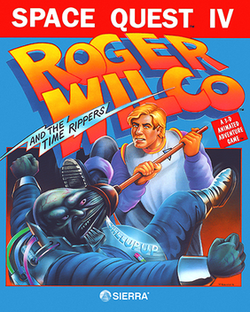Space Quest IV: Roger Wilco and the Time Rippers
| Space Quest IV: Roger Wilco and the Time Rippers |
|
|---|---|

Cover art by Terry Robinson
|
|
| Developer(s) | Sierra On-Line |
| Publisher(s) | Sierra On-Line |
| Director(s) | Bill Davis |
| Designer(s) |
Scott Murphy Mark Crowe |
| Programmer(s) | Scott Murphy Doug Oldfield |
| Artist(s) | Mark Crowe |
| Composer(s) |
Mark Seibert Ken Allen |
| Series | Space Quest |
| Engine | SCI |
| Platform(s) | DOS, Windows, Macintosh, Amiga, NEC PC-9801 |
| Release | March 4, 1991 |
| Genre(s) | Adventure |
| Mode(s) | Single-player |
Space Quest IV: Roger Wilco and the Time Rippers is a 1991 graphic adventure game by Sierra On-Line. It was released on floppy disks on March 4, 1991, and released on CD-ROM in December 1992 with full speech support and featuring Laugh-In announcer Gary Owens as the voice of the narrator. It featured 256-color hand painted graphics and a fully mouse-driven interface. It was one of the first games to use motion capture animation. The game cost over US$1,000,000 to produce and sold more than its three predecessors combined. An Atari ST version was announced via Sierra Online's magazine, Sierra News Magazine, but was later canceled.
In this installment, Roger embarks on a time-travel adventure through Space Quest games both past and future. An infomorph of reborn Sludge Vohaul from Space Quest XII: Vohaul's Revenge II chases Roger through time in an attempt to finally kill him. Roger also visits Space Quest X: Latex Babes of Estros (whose title is a parody of Infocom's game Leather Goddesses of Phobos) and Space Quest I; in the latter, the graphics and music revert to the style of the original game and Roger is threatened by a group of monochromatic bikers who consider Roger's 256 colors pretentious. None of the gameplay takes place in Space Quest IV. In fact, the "actual" Space Quest IV is only seen briefly in the introduction.
In contrast to the first three games, Space Quest IV uses a point-and-click interface, featuring icons for different actions. The icons are an eye, a talking head, a walking person, a hand, a mouth, and a nose, representing look, talk, walk to, use, taste, and smell, respectively. The last two almost never do anything other than provoke a humorous response from the game.
...
Wikipedia
